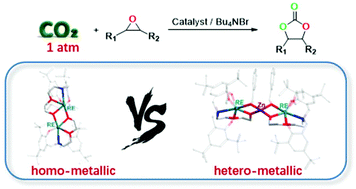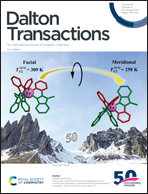Heterobimetallic rare earth metal–zinc catalysts for reactions of epoxides and CO2 under ambient conditions†
Abstract
Four homodinuclear rare earth metal (RE) complexes 1–4 bearing a multidentate diglycolamine-bridged bis(phenolate) ligand were synthesized. In addition, seven heterobimetallic RE–Zn complexes 5–11 were prepared through a one-pot strategy. In these heterobimetallic complexes, two RE centers are bridged by either Zn(OAc)2 or Zn(OBn)2 moieties. All complexes were characterized by single crystal X-ray diffraction, elemental analysis, IR spectroscopy, and multinuclear NMR spectroscopy (in the case of diamagnetic complexes 1, 4, 7 and 11). Moreover, the multi-nuclear structures of complexes 4 and 11 in solution were also studied by 1H DOSY spectroscopy. These complexes were applied in catalyzing the coupling reaction of carbon dioxide (CO2) with epoxides. Zn(OAc)2- and Zn(OBn)2-bridged heterobimetallic complexes showed comparable catalytic activities under ambient conditions and were more active than monometallic RE complexes. Significant synergistic effect in heterobimetallic complexes is observed. Mono-substituted epoxides were converted into cyclic carbonates under 1 atm CO2 at 25 °C in 88–96% yields, whereas di-substituted epoxides reacted under 1 atm CO2 at higher temperatures in 40–80% yields.



 Please wait while we load your content...
Please wait while we load your content...